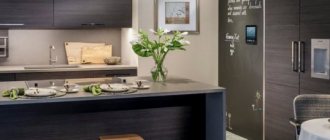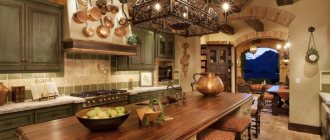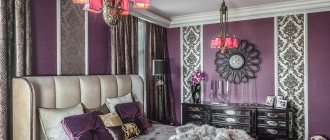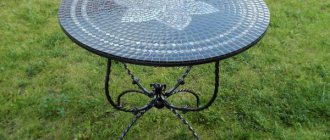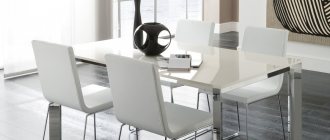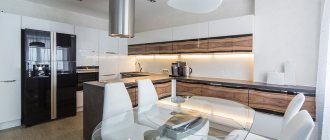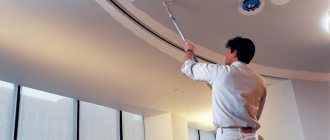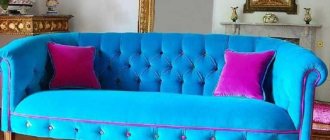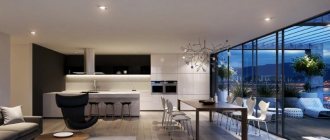Today, there are about a dozen different materials that your kitchen countertop can be made from, and each of them has its own unique properties.
Here is a list of them, sorted from the most popular to the least popular material (to quickly jump to a review of the desired material, just click on an item in the list):
- laminated chipboard
- MDF
- Acrylic
- Agglomerate (quartz)
- Natural granite
- Solid wood
- Natural marble
- Ceramic tile
- Steel
At the end of the review we give some very important recommendations, as well as a useful video.
Next, we will look in detail at the pros and cons of each of these types, so that you can understand for yourself which countertop is best to choose for the kitchen, which one will be the most practical and high-quality.
Ideal tabletop image
As you know, the countertop is the working surface of any kitchen, which is a slab of a certain material that covers the cabinets of the lower section of the kitchen unit.
Due to the fact that the countertop plays a very important functional role, it is subject to a number of mandatory requirements that must be met regardless of the material of manufacture:
- waterproof and moisture resistant;
- resistance to aggressive substances - acids, dyes, oils, household chemicals;
- resistance to mechanical stress - scratches, abrasions, impacts of dishes and appliances;
- resistance to thermal effects;
- hygiene - the surface should be easy to clean from stains and dirt;
- color fastness against abrasion and UV rays;
- beauty and aesthetic properties.
Essentially, the above requirements are listed in order of decreasing importance, i.e. from the most important to the less significant parameter that influences the final choice.
Let's take a closer look at each of the materials from which kitchen countertops are made these days.
Dark work surface
Dark shades of the work surface attract with practicality; in glossy and matte versions they look equally advantageous together with a light or dark kitchen set.
Black color
The black tabletop and anthracite colors look stylish. Suitable for a medium-sized kitchen or larger, it visually separates the upper cabinets and lower cabinets. Looks good in any style.
In the photo, a black glossy countertop in the interior style of modern classics acts as a stylish accent and a practical solution.
Galaxy color
Galaxy color is suitable for a kitchen that wants to diversify without using decor. The pattern represents smooth transitions of colors with characteristic inclusions.
Dark brown color
Dark brown shades, cappuccino color, chocolate, look good with the same floor or dining table. Suitable for light, white kitchens as a contrast.
Dark grey
A dark gray work surface looks neutral, fits any style, and combines with white, pastel, and gray shades of the kitchen.
Tabletops made of laminated chipboard
These countertops are made by treating particle board with high pressure plastic (HPL).
Enveloping the chipboard with a layer of plastic occurs through the use of postforming technology.
So, the advantages and disadvantages of laminated chipboard:
| pros | Minuses |
| Availability (from 15 USD per linear meter). | Not resistant to dyes and other aggressive liquids (wine, fruit juices, coffee and even city water), which can cause permanent stains. |
| Fast production (5 – 10 days). | If water gets into an unprotected area of the base, swelling may form (especially in places where sinks and joints are inserted). |
| Wide range of colors and manufacturers. | During regular use, it may lose color in places where stains were frequently wiped off or abrasives were used. |
| Easy and inexpensive installation (you can even do it yourself). | Weak heat resistance. |
| In view of the above, it is painless to change both in terms of budget and time. | Its production uses formaldehyde resins that are harmful to humans (be prepared for the fact that it will have to be weathered for 3-5 days, and only then installed). |
| Short shelf life (average 5 years). |
Despite a number of disadvantages, this type of surface is most often used as a countertop in kitchens in the CIS (⅔ of the market).
Here is one of the many reviews about countertops made of laminated chipboard.
Of course, those consumers who can afford to spend 100-300 USD. per linear or square meter, they consider laminated chipboard an unworthy material.
We believe that chipboard countertops laminated with HPL plastic are the best choice in the budget class.
What you need to check with the seller before purchasing:
- When purchasing laminated chipboard, be sure to pay attention to the emission class of the board, which indicates the formaldehyde content. It should be E1 (ideally E0), but in no case E2 or higher;
- Look at the cut of the slab - in most cases, moisture-resistant chipboard, in addition to special markings (P5), is distinguished by a green or blue coloring pigment;
- The type of plastic should be HPL (High Pressure Laminate) and not CPL. It is an order of magnitude better in all respects.
All of the above parameters will affect the final price of the countertop.
Chipboard in plastic (postforming) - an economical option for the thrifty
The plastic kitchen worktop has a base made of chipboard or MDF and is equipped with a rounded front edge with a drip tray. There are two types of chipboard countertops: regular and moisture-resistant. Visually, a moisture-resistant product can be distinguished by looking at the cut - it has a greenish tint. All postformings with an MDF base are considered to be waterproof.
Plastic kitchen countertops are made using the postforming principle - a standard strip of a certain width, with a radius on one or both sides.
Pros:
- democratic pricing policy,
- heat resistance,
- the presence of a drip tray,
- wide range of colors (for example, wood, tile imitation, marble, etc.),
- ease of installation,
- ease of care.
Minuses:
- low threshold of moisture resistance - if the rules for processing the ends are not followed, it is prone to swelling during operation (especially in the washing area);
- deformation of the top layer is possible at too high temperatures (near the oven, mortise surface). After such deformation, the countertop may need to be replaced;
- limited size range - standard tabletop sizes do not allow creating seamless configurations in corner kitchens; metal or plastic overlays have to be used to join several parts;
- if it is necessary to create a radius or beveled figure, the front protection has to be cut off, which compromises the integrity and reduces the service life.
MDF
In the manufacture of such countertops, an MDF board is taken as a basis, which is covered with a high-strength laminate (the same HPL) and then coated with a special protective layer.
In simple words, MDF countertops differ from their laminated chipboard counterparts only in the plate itself (base), and are laminated with the same high-pressure plastic.
MDF differs from chipboard in its higher chip density and the absence of resins harmful to humans.
The advantages and disadvantages of such countertops can be identified as follows:
| pros | Minuses |
| Availability (from 30 USD per linear meter). | Resistance to dyes and acids greatly depends on the quality of the plastic. Over time (depending on the intensity of use) it may lose color in places where stains have been actively wiped off. |
| In production, no resins that release formaldehyde are used, but paraffin and lingin are used. | Weak heat resistance. |
| A variety of colors, the ability to imitate complex textures, a wide selection of manufacturers. | Not very high resistance to strong impacts. If a heavy object falls onto the surface, it may leave a small dent. |
| Resistant to fungi and microorganisms. | In case of prolonged exposure to water, the joints may swell (it should be noted that MDF, compared to chipboard, absorbs moisture much worse). |
Here is a review in defense of MDF countertops:
What you need to check with the seller before ordering:
- What plastic is used in the proposed board? (needs HPL);
- What is its thickness? (this greatly affects the price, but also durability);
- What is the moisture resistance class?
- What and how are the ends covered?
MDF Kitchen Worktops
Everyone understands that this type of product is constantly exposed to chemical and mechanical stress, so you need to choose a product that is not afraid of scratches, chips, and does not change its shape.
If your budget is limited, and the set itself is made of MDF, then you can also choose MDF for the countertop. It is a particle board made from wood shavings.
Advantages
- Does not emit environmentally harmful substances;
- The price is available for every buyer;
- Service life - about five years;
- Care is very simple and does not require much effort;
Flaws
- Poor moisture resistance (therefore, after some time the product swells);
- Low heat resistance;
- Does not withstand strong mechanical shocks;
- Over time it fades and loses color.
The dimensions established by the GOST standard are 3059 mm length, 600 mm width, 38 mm thickness.
Acrylic surfaces
The production technology of such countertops consists of binding very fine mineral chips (aluminum trihydrate) and color pigments with acrylic resin (hence the name), which is poured into the mold required by the customer.
Due to this, the working surface can be made in almost any geometric shape without compromising strength, without seams or joints.
Sometimes this material is also called “liquid stone”.
The pros and cons of such countertops for the kitchen include the following.
| pros | Minuses |
| Ideal for complex design solutions in modern kitchens. | Expensiveness (from 100 USD per sq.m.) both of the tabletop itself and of all kinds of components necessary for its full installation. |
| Has an impressive, presentable appearance | Subject to mechanical damage. It is highly not recommended to cut on such a surface; scratches will appear instantly. |
| Solidity and seamless joints. | Easily susceptible to acid attack and dyes (juices, wine, coffee, etc.). If contaminants come into contact with the surface, the surface must be wiped immediately. |
| Very varied color range. High imitation of the texture of natural stone. | Complex installation (in 99% of cases it is carried out only by the manufacturer’s specialists). |
| Environmentally friendly and hygienic (complete absence of pores, respectively, no bacteria, fungi, mold, etc.). | Low heat resistance (it is strictly forbidden to place a hot pot or frying pan). |
| Does not fade or fade color. | Long production time (from 3 weeks). |
| Has a “warm” effect upon tactile contact. | |
| Good maintainability. |
Speaking of color options, you can actually choose any color for the countertop.
The manufacturer, through variations of the dye and base, can offer you almost any surface texture or color.
Reviews about this material are quite contradictory. For example:
Of course, there are more positive reviews.
That is, the main thing that owners of such countertops complain about is the occurrence of scratches.
We would recommend not choosing dark colors (even though they look more expensive), because... Scratches are very visible on them, but on light ones they are almost invisible.
What you need to check with the seller before purchasing an acrylic countertop:
- What is the thickness of the stone - at least 6 mm, well, better than 12 (we are talking about the thickness of the acrylic layer without a backing);
- What acts as a substrate and how does its type affect the cost?
- Who is the manufacturer? The best brands are Corian, Staron, Hi-Macs, Rehau;
- Is there a warranty and how much will it cost to sand out scratches in the future?
Color of the table, floor, apron, sink and countertop
The color of the tabletop can be harmoniously combined in contrast or resonate with the color of the dining table, floor or apron.
Dinner table
The tabletop can be matched to the color of the dining group if it is in the kitchen. In order to diversify the color palette, you can choose a companion color, for example, a gray table and a white countertop. Also for a classic style, a combination of one color is suitable, for example, sand and yellow in different tones.
In the photo, the worktop and island part of the kitchen are different in color, but look organic with the set and the shade of the floor.
Floor
A flat work surface can match the color of the kitchen floor. For example, dark wood laminate or laminate tiles will go well with the same countertop. A contrasting glossy black floor will pair with a matte light surface, and dark beige tiles will look good with a honey-gold countertop.
In the photo, the color of the floor matches the set, and the countertop matches the color of the kitchen walls.
Apron
You should not choose the same tone for the apron and work surface, as this space will not provide a visually clear line of demarcation. It is better to choose one color in different shades, for example, lilac and violet, or light gray and the color of concrete. For contrast, a glass apron with a photo print or a mosaic apron are suitable. If the countertop in the kitchen is glossy, then it is better to choose a matte apron.
In the photo, not only the apron, but also the walls are made in the same color as the work surface in a gray and white high-tech style interior.
Sink
The kitchen sink can be ceramic, metal or stone, so it can match the color of the countertop or stand out in contrast. The work surface looks seamless and merges with the sink. The overall style is emphasized by a stainless steel sink with a gray countertop.
In the photo, the sink and countertop are matched in the same color, which makes the work surface uniform and without color differences.
When choosing a kitchen countertop, you need to take into account the size of the room, the color of the furniture and the finish. A bright work surface itself serves as an accent, and a neutral one serves as a background for kitchen utensils.
Countertops made of agglomerate (quartz)
Popularly, these countertops are better known as quartz, artificial granite, or agglomerate.
The composition of such an agglomerate consists of 90-95% solid components - granite, marble or quartz chips, as well as binding elements.
Unlike acrylic, agglomerate actually uses stone, as well as harder resins - epoxy.
Obviously, thanks to this composite, work surfaces made of this material are much stronger and more reliable than acrylic ones.
The agglomerate has very important advantages, and its disadvantages, in some cases, are absolutely insignificant.
| pros | Minuses |
| It has a spectacular, expensive, presentable appearance. Maximum level of stone imitation. | The highest cost (more expensive than acrylic, natural stone, especially if there are a lot of cutouts). |
| Excellent resistance to acids, dyes and weight loads. | The range of color options is small (compared to acrylic counterparts). |
| Resistant to high temperatures (short term). | Visibility of joints (irrelevant for lengths up to 2.5 m). |
| The color is not susceptible to abrasion, fading, or fading from UV. | Low level of maintainability in case of chips, etc. |
| Maximum hygiene and harmlessness. | Heavy weight (need to strengthen the frame of the headset). |
| Durability – from 10 years. |
Please note that, unlike acrylic, quartz surfaces are an order of magnitude heavier. This must be taken into account when calculating the load on the headset.
Among the manufacturers of quartz agglomerate countertops, we would recommend:
- CaesarStone;
- Samsung;
- PlazaStone.
And here is one of the real reviews about such surfaces:
What you need to check with the seller before purchasing:
- What is the thickness of the stone without a backing - experts recommend at least 12 mm, and for maximum reliability 20 mm;
- What acts as a substrate (chipboard, MDF, blown glass)?;
- What will be the final weight of a countertop made of such artificial stone? This is important to know for the correct design of the lower section of the headset (for example, reinforcement of the walls may be required);
- What will be the full price - the countertop, all the cutting and cutting work, delivery, installation and related fittings.
In our opinion, agglomerate countertops are the best option among premium kitchen worktops.
Read also - a detailed review of the pros and cons of countertops made of artificial stone.
Real granite countertops
The basis of such countertops is, as you already understood, natural granite.
They have some of the best wear-resistant qualities and are not susceptible to mechanical and chemical attack from appliances, food, and household chemicals.
So, speaking about kitchen countertops made of natural granite, you need to know the following.
| pros | Minuses |
| It looks the most natural and sound. | High cost of countertops (from 200 USD per sq.m.), carving and installation work. |
| Excellent resistance to moisture and various types of acids. | Very limited color range. |
| Not afraid of thermal loads of any level. | Visibility of joints (a single piece can be counted on if the length does not exceed 2.5 m). |
| Resistant to color loss from mechanical stress or ultraviolet radiation. | Can absorb strong dyes (remains stains that cannot be removed). |
| The surface is easy to clean and “impervious” to any microorganisms. | The heavy weight of the surface requires a reinforced design of the pedestals on which it will be placed. |
| Shelf life - can last for decades. | It cannot be repaired after severe mechanical damage (but it takes a lot of “smartness” to apply it). |
| . | There are cases when granite has an increased background radiation. |
What you need to ask the manufacturer before ordering:
- First of all, a granite deposit?;
- Is there a quality certificate for this product?;
- Does the quality certificate indicate the class of granite based on the specific activity of natural radionuclides? He must be 1st class (see picture below);
- What will be the final weight of the tabletop?
- Naturally, what will be the price of such a working surface, taking into account the cost of the material and all the work.
Requirements for kitchen countertops
The kitchen area is constantly exposed to daily temperature changes, high levels of surface contamination and other influences. All types of kitchen countertops are no exception. Therefore, we decided to give advice on choosing this product.
The product must match the interior of the kitchen, have good practicality, long service life and an affordable price.
Criterias of choice:
Forms
The product is manufactured in two forms:
- cut;
- Solid.
In the case of a cut shape, the individual elements are connected to each other using special elements. When continuous, the surface is uniform, completely sealed.
Dimensions
Products have different size standards. Each material has its own value, which we will introduce you to a little later.
“Housewives are advised to purchase types of kitchen countertops that are wider than the cabinets themselves.”
Colors
There are no specific tips for choosing colors. The main thing is that it is appropriate and NOT superfluous. The correct selection of colors for kitchen countertops will add zest to the interior and create a unique design.
“In order not to make a mistake with the colors, attach samples of the facades to the product.”
There may be many suitable options, so be guided by your taste and do not listen to other people’s opinions. The ideal option is products made from universal shades .
Kitchen countertop colors
For a white kitchen set, stone (cold) or wood material (light) is ideal. It is better to dilute a beige set with dark chocolate or solid chocolate. Both types are complemented by products that do not differ in color from the surface of the facades, but then you need to highlight the wall panel.
Dark types of kitchen countertops always look luxurious, especially in combination with a light interior. In the photo you will see for yourself how unusual the interior immediately becomes.
“Focus on only one of three options: the color of the set, the kitchen countertop, the wall panel.”
Wood, stone, cream and white colors are perfect for wooden facades.
If the kitchen set is two-color, choose types of kitchen countertops with colors for the upper part of the set, but also in parallel with the bottom.
Types and Materials
- MDF;
- chipboard;
- Wood;
- Types of kitchen countertops made of artificial stone;
- A natural stone;
- Glass;
- Metal;
- Types of kitchen countertops made of ceramic tiles.
Solid wood
Made from wood species with a high threshold of durability and strength.
The most popular species from which such countertops are made are oak, walnut, ash, bamboo, and iroko.
The main characteristic when choosing an array is minimal flexibility to moisture and mechanical stress.
| pros | Minuses |
| Great natural look. It adds coziness to the kitchen and captivates with its natural warmth. | Very poor heat resistance and fire resistance. |
| Gives a very pleasant tactile sensation upon contact. | Due to changes or differences in humidity levels, it may dry out or sag. |
| With proper varnishing and care, it is resistant to moisture. | If moisture gets into unprotected joints or cracks, it may swell. |
| Average cost (using common breeds). | Weak resistance to acids and dyes. |
| Can be sanded repeatedly to update its appearance. | Requires regular careful maintenance. |
| Can be sanded repeatedly to update its appearance. | If it gets wet often, it is susceptible to fungi and microorganisms. |
| If used carelessly in places where there is constant accumulation of moisture, it is susceptible to the influence of fungi and microorganisms. |
Despite a number of disadvantages, in Europe, especially in the UK and Scandinavian countries, wooden worktops are very popular.
Here's an interesting review:
So, if you are ready to put up with some shortcomings, but still really want a solid wood countertop, go for it!
What you need to ask the manufacturer before ordering:
- First of all, what types of wood are offered? As mentioned above, the best choices are oak, wenge, beech, ash and walnut. Less commonly, larch, cedar, iroko;
- What is the class of the array? Its knotiness depends on this (ideally you need A or A/B);
- What is the thickness of the shield - experts advise 40 millimeters;
- What will the tree be covered with?;
- How to care for such a countertop and where to buy special products?;
- What mounting hardware will be used for installation?
Marble
Another type of natural stone that is used as a kitchen work surface.
Compared to granite, marble looks much more beautiful, but at the same time, it has a number of quite significant disadvantages.
| Advantages | Flaws |
| Aesthetic factor (deep unique texture) | Very sensitive to dyes (coffee or wine stains should be wiped off immediately). |
| Gives a feeling of good quality, reliability and aristocracy. | Does not like temperature changes (a crack may even form). |
| Keeps cool (pleasant in the hot season). | Do not place anything hot (the stone will turn yellow). |
| The edges are at risk of chipping. Extremely low maintainability. | |
| Expensive material (although cheaper than agglomerate, granite and acrylic) and installation. | |
| Limited palette. | |
| Requires regular care. |
In general, with careful and attentive treatment, a marble countertop will be an excellent option for spacious kitchens designed in a classic or neoclassical style.
Here is one of the reviews about such countertops.
What you need to pay attention to before ordering:
- Check out the available palette;
- Ask for a quality certificate for marble and pay attention to the radionuclide content class (as in the case of granite);
- What is the price per square meter, cutting labor, delivery and installation?
Light work surface
A light countertop is suitable for the interior of a kitchen of any style; it combines equally well with a light or dark kitchen. It is easily soiled and requires careful treatment on the part of the owner.
White color
The most popular and controversial color is white for the work surface. Glossy ideal surfaces are suitable for modern style, hi-tech, minimalism, Scandinavian. Combines with white or contrasting kitchen. A classic matte white stone countertop suits a conservative style.
Beige color
Beige in light shades of ivory, champagne, milky, vanilla, suitable for neutral countertops that act as a background for an apron or set.
The photo shows a white kitchen interior with a vanilla-colored countertop, which does not attract attention, but at the same time separates the upper and lower space.
Sand color
The sand color of the countertop should be selected for a kitchen with wooden facades and warm lighting, as well as for a dark set.
Light gray color
A light gray countertop is suitable for white, gray and dark gray furniture, as well as the color of concrete, which does not highlight the remains of splashes and possible crumbs as much as white.
The photo shows a light gray countertop on the island table and the main work area; the color matches the walls and looks organic with the white set.
Metallic color
Metallic color or a tabletop made of aluminum/stainless steel in a steel shade is best used when creating a high-tech style. This is a practical choice for kitchens where you cook frequently.
The photo shows a metallic countertop that fits into the blue and white interior of a modern kitchen and resonates with kitchen appliances.
Ceramic tile countertops
In our apartments and houses this type can be found quite rarely.
However, there are people who like just such countertops.
As a rule, they are laid out either with medium-sized tiles, or with small mosaics, or all together.
Often, the base on which the tiles are laid is chipboard.
Let's look at the pros and cons of such a work area.
| pros | Minuses |
| It looks very beautiful and colorful. | Traces from food, drinks, etc. will constantly accumulate on the seams (in the grout). |
| Resistance to high temperatures (if high-quality tiles). | It will be very difficult to replace (for example, a cracked tile, not to mention the entire countertop). |
| Resistance to moisture and acids, immunity to dyes (except for seams). | Not a cheap option. |
| Average cost (using common breeds). | Weak resistance to acids and dyes. |
| Not afraid of mechanical impact. | |
| Wide selection of variations as possible. | |
| Wide range of color possibilities. |
In fact, the cost of such a work surface will be 90% directly dependent on which tile you choose.
Here is a useful review, in our opinion, from the owner of a ceramic tile countertop.
In our opinion, this option for designing a work area is greatly underestimated, because it has many advantages.
What you need to understand before deciding to make such a countertop:
- First of all, you need to decide on the type of tile: mosaic, small or medium, what kind of pattern, etc.;
- Next, understand how much you need to buy such tiles and how much the installation work will cost;
- Approximately how much will such a surface weigh and what kind of frame should be made?
Choosing a color countertop
To create a bright accent in the kitchen, just choose a colored work surface, which will be complemented by wallpaper or textiles.
Red
A red tabletop is often found in combination with white and dark furniture. Red gloss can be repeated in the color of the dining table or floor finish.
Burgundy
It is better not to combine burgundy with red; it is suitable for the modern design of a light kitchen.
Orange
An orange countertop is suitable in combination with white furniture for a small kitchen, and in combination with dark brown furniture for a spacious room.
Yellow
Yellow adds light to the room, but it is best to choose it only for the tabletop and one other decorative item, such as potholders or a teapot, because yellow can cause eye fatigue.
Pink
Suitable for lilac, pink, white, gray headset. A kitchen with a pink countertop looks impressive and at the same time non-aggressive.
Blue
Blue is best combined with gray and white kitchens in Mediterranean and modern styles.
Green
It has a beneficial effect on vision and is suitable for any size room. A light green shade of the countertop is suitable for a large space and a kitchen set in white, light gray, dark brown shades. The olive color looks good in a Provence style kitchen and creates a noble atmosphere.
In the photo, the bright lime-green work surface acts as an accent and harmoniously combines with the white facade and mosaic apron.
Turquoise
A turquoise tabletop goes equally well with dark brown, white and black furniture, as well as with colored yellow and pink facades.
Violet
A purple work surface can be combined with the same walls, but it is better to choose a light beige color for the facades. A lilac countertop is suitable for a Provence style kitchen or a modern small kitchen.
The photo shows a combination of a purple table, countertop and mosaic tile elements in a colored kitchen, the set of which consists of three colors.
Steel
The first association that comes to most people in connection with a steel work surface is a kitchen in a restaurant or other catering establishment.
Yes, it so happened that, thanks to its properties, “stainless steel” best meets sanitary and hygienic standards in many countries.
However, let's compare the advantages and disadvantages of this material as a base for a countertop.
| pros | Minuses |
| Strength and durability. | Fits a very limited number of kitchen styles. |
| Resistance to any kind of aggressive liquids and products (dyes, acids, fats, chemicals). | There are very few manufacturers (only in large cities) and relatively high cost. |
| Resistance to moisture and acids, immunity to dyes (except for seams). | Not a cheap option. |
| Some of the best indicators in terms of sanitary and hygienic standards. | Fingerprints, stains and other traces remain, i.e. It is advisable to wipe regularly. |
| Any contamination is easily washed off. | With active use, it may lose its former shine and gloss (removed by polishing). |
| Wide selection of variations as possible. | |
| If the interior style is unsuccessful, it will give a “catering effect”. |
If we talk about interior styles where such a tabletop would be acceptable, then this is loft, hi-tech or industrial.
Below is one of the reviews related to stainless steel work surfaces.
What you need to ask the manufacturer before ordering:
- What will act as a substrate?
- What options are there for steel thickness?
- How to care for such a surface and do you need special equipment for this?
Expert advice: which countertop to choose for the kitchen
The shape is selected based on the area and layout of the room, combination with the set. If you want to experiment in a new home, you need the advice of a specialist who can determine the pros and cons of materials, the complexity of installation, and select related materials.
Focuses on:
- kitchen design (for a simple set, choose a simple countertop);
- area (a countertop with a large pattern is not suitable for the design of a small kitchen; it will put pressure on the entire space);
- surface texture (matte, more practical with inclusions);
- sensations when touched.
The material of the countertop should be pleasant to the touch.
Expert advice on which countertop to choose for the kitchen:
- review the materials supplier’s documents;
- determine environmental friendliness and hygiene;
- determine whether the price corresponds to financial capabilities;
- find out how long the selected material lasts.
For chipboard, it is important that the moisture resistance of the board is P2, class E0, E1, thickness 38 mm. MDF class A, A/B, thickness 32-42 mm. The array is selected independently (without knots or stains). It is important to be present during installation in order to control the accuracy of the cutouts, the accuracy of the fit to the wall, the quality of the joint processing and the seams with sealant.
If we talk about how to choose a quality countertop for a kitchen, it should be noted that this indicator depends not only on the characteristics of the material, but also on the integrity of the manufacturer and installers. Even moisture-resistant chipboard will be damaged by water if the seams are poorly processed.
You should not pay special attention to the complexity of care, which is indicated in reviews. Any surface must be maintained to prevent deformation. The most durable coating is damaged if you do not remove liquids in time, do not use coasters and napkins, or drop heavy objects. The work surface lasts longer for housewives who do not neglect these rules.
A few final tips
For dessert, we have prepared a few more practical tips that will help you avoid a number of unpleasant surprises:
- 1. The simpler the set, the simpler the tabletop should be and vice versa. There is not the slightest sense in installing a marble surface on a chipboard kitchen or a cheap laminated chipboard countertop on a set of natural wood;
- 2. Natural stone countertops are best suited for spacious kitchens (from 20 sq.m.) and are inappropriate in small rooms with an area of 4 - 6 sq.m. (Khrushchev-era buildings);
- 3. Whatever countertop is installed for you, be sure to be present during its installation. Control how accurately the surface is cut, how it fits to the wall and the lower section, how the baseboards and edges are installed;
- 4. Surfaces made of granite, marble, quartz are very hard, so you will need to learn to place dishes (plates, cups, etc.) more carefully;
- 5. Regarding the question of which countertop is better: glossy or matte, let’s say the following. Experience shows that matte countertops (of any type) are more practical than glossy ones. Moreover, this is confirmed by dozens of reviews on specialized forums and websites;
- 6. Look and feel the display finished countertop in the material you like. No samples or pieces will give you such a complete picture as an already made and installed surface;
- 7. In cases of ordering a tabletop made of solid wood, it is vitally important to independently and personally select the piece from which it will be made (+ take a photo several times). This must be done so as not to later discover unexpected knots, spots or textures you don’t like on the finished product;
- 8. Light colors are better for surfaces covered with plastic (chipboard and MDF). This is due to the fact that over time, in places where stains (especially difficult ones) have been frequently wiped off, the plastic will lose color a little. On a dark surface this is very noticeable, but on a light one it is an order of magnitude less noticeable;
- 9.You can ask the manufacturer not to throw away the pieces of stone that remain after cutting out places for a sink or hob. They can be used for a coffee table or used in the country house.
- 10. If you don’t know whether it’s better to choose plastic or artificial stone, then you should start from your budget. Laminated chipboard countertops are cheaper, but they are inferior in many characteristics to agglomerate, which costs several times more, but it is definitely better than even the highest quality plastic.
As you can see, there is no 100 percent ideal material that would fully meet all positive requirements and at the same time be free of shortcomings. However, we have told you everything that we, as well as owners of such countertops and experts from manufacturing companies, know.
We hope that we have helped you decide which material will be the best choice for the work surface of your kitchen.
If you have interesting experiences or any other useful information regarding the selection and use of kitchen countertops, share them in the comments!
Kitchen and countertop color
You can choose a color based on the rules of combination in tone or contrast. You can also choose the color of the work surface to match the color of the headset.
| Facade | Tabletop |
| The gray façade serves as a backdrop for eye-catching elements and details and is combined with neutral and bright tones. | White, light grey, dark grey, black, red, orange, dark green, pink, lilac. |
| The white façade is versatile and can be combined with many colors, an ideal choice for kitchens of any size. | White, black, gray, red, burgundy, orange, brown in dark shades, bright shades of pink, green, yellow, purple, blue, turquoise, pastel colors. |
| Blue itself is attractive and needs to be balanced with neutral shades of textiles, aprons, walls and work surfaces. | White, light grey, beige, orange, yellow, black, light brown. |
| Beige goes well with any warm and cold shades. | Beige is a tone lighter or darker, white, brown, chocolate, vanilla. |
| Green kitchen furniture is best combined with neutral or warm colors. | Yellow, red, brown, white, black, gray. |
| Black attracts attention and needs to be diluted with light tones. | Pink, lilac, white, gray, metallic, black, brown, all shades of wood. |
The photo shows a blue set, which in the kitchen interior is complemented by light gray walls, a brick wall, a black dining group and a gray countertop. Good lighting is important for this combination.
